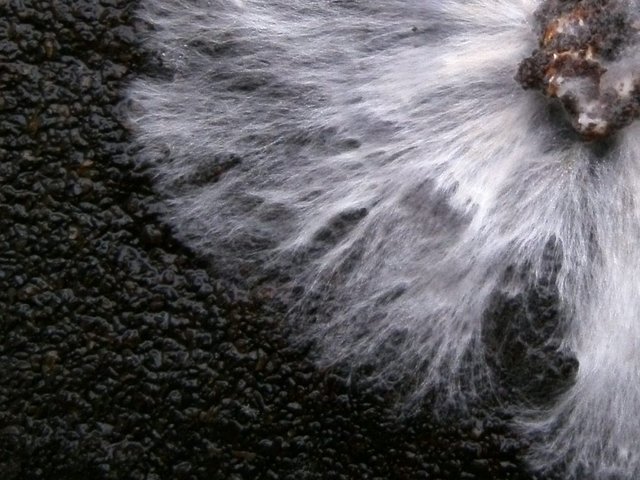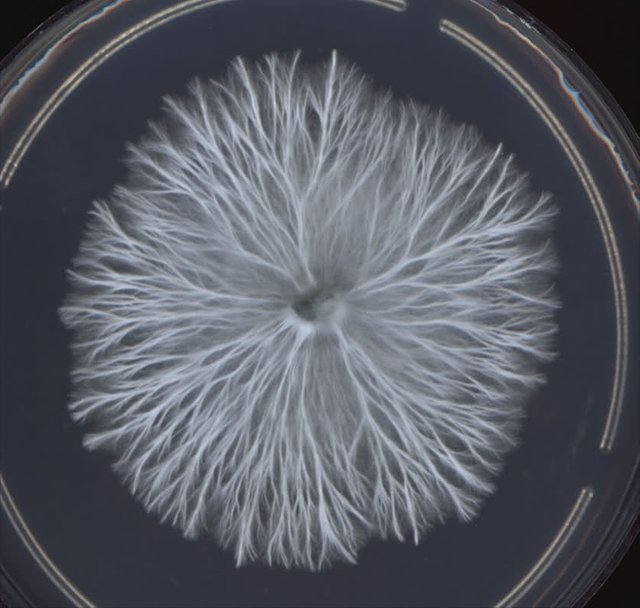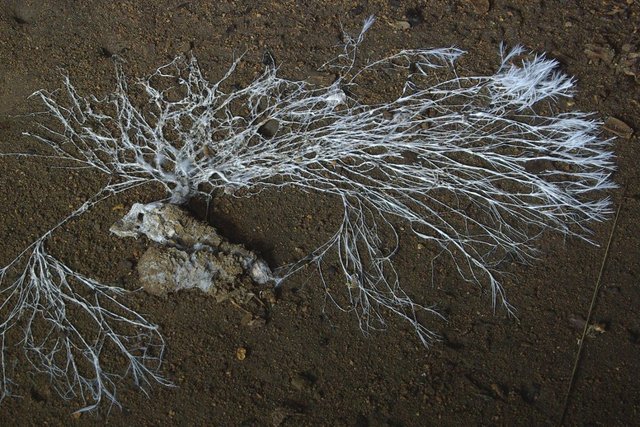Bound for the Shady Grove (an original story) PART 2 of 3

“I was right around here somewhere,” said Lindy Ray, walking tight circles on the forest floor and brushing leaves away with her sneakers. Her dad and Treva Breedlove both squatted down to help her look.
“I’ll tell you what,” said Dr. Breedlove. “If this fungus does what you say it does, you’re going to be responsible for a momentous discovery. How would you like to have a mushroom named after you?”
“I could deal with that,” Lindy giggled.
“My daughter, the preeminent mycological discoverer,” said Roger. “Dr. Lindy Ray Tate. Kinda has a ring to it, don’t you think?’
“Here!” called Lindy, when she found the depression she’d left in the ground during yesterday’s nap. She bent down, cleared away some forest debris, and located the mycelial network underneath. She pushed an errant strand of hair behind her ear and then placed her hands on the ground, in contact with the mycelium. Roger and Dr. Breedlove gathered close to watch. “I don’t know how long it takes,” she said. “But it can’t be very long, because the sun hardly moved while I was asleep.”
It took a few moments, no more. Lindy felt it on the undersides of her hands before she could see it; a sort of ticklish, latching-on sensation, like an adhesive bandage being applied to the skin. “I feel something!” she said.
Dr. Breedlove removed her glasses, polished them on her t-shirt and replaced them. She leaned her head closer to the ground, as Roger did the same. Several minutes passed in silent anticipation before the first, fuzzy filament began to climb up the junction between Lindy’s forefinger and thumb.
“Well, I’ll be damned,” said Roger, his voice low, reverent.
More strands appeared, ascending Lindy’s wrists like vines growing up a tree.
“Incredible,” Dr. Breedlove said.
Lindy Ray’s mind was blank as snowfall as she observed the fungus’ creeping enterprise. She stared at it, lost in the physical sensations until her trance was abruptly shattered by, of all things, a song.
She heard it clear as crickets on a summer night, a sad old Appalachian folk song, heavy and haunting. It was sung in her father’s gruff voice, woven through the mournful tone of his fiddle, though Roger was still standing there, arms hanging limp by his sides, staring slack-jawed at the mycelial marvel.
And am I born to die
To lay this body down
And must my trembling spirit fly
Into a world unknown
Her scalp prickled and a shower of needles cascaded down her spinal column. That’s odd, she thought. It haven’t thought of that song in years. Odder still was the unshakeable impression that the melody had not arisen through her normal thought process, but that it was being, somehow, drawn from her. She shuddered.
She looked up. Both Roger and Dr. Breedlove were still gazing at the fungus, enraptured. “Shouldn’t I stop now?” she said, feeling slightly guilty for interrupting their moment. “I mean, we don’t know what the fungus does. It might be eating me, or poisoning me, or—something else.”
Dr. Breedlove snapped out of her reverie and resumed her normal, academic air. “You’re absolutely right, Lindy,” she said. “I’ve got some alcohol wipes in my backpack. You should use those right away. My god, we’ve got to get a specimen. Did you see any fruiting bodies around?”
“No,” said Lindy. “I looked yesterday, but I couldn’t find any mushrooms.”
“But it’s been dry lately, Treva,” said Roger. “We should come back after the next rain.”
“Of course,” agreed Dr. Breedlove. “But in the meanwhile, I’m going to take a sample of the mycelium back to the lab. I’d be crazy not to.” She unzipped her backpack, pulled out a handful of alcohol wipes in foil wrappers and handed them to Lindy, who busied herself decontaminating her hands and arms. Then Dr. Breedlove retrieved a small, sharp pointed spade and a wax paper bag and set to work removing a square of myceliated soil from the ground.
“There we go,” she said, brushing the dirt off of her knees as she carefully sealed the block of soil in its bag. “There might not be much I can do with this, but I’ll try to get it growing onto some substrate in the lab. Lindy, would you like to come by in a couple of days to help me with some research? You discovered the fungus, after all.”
“I’d love to,” she said.

Treva Breedlove’s lab was housed in a climate controlled, metal building behind her house in Mars Hill. Lindy Ray parked her dad’s old pickup truck in the driveway, stopped in the house for a friendly word with Mr. Breedlove, and then made her way out back. She followed a meandering path through the vegetable garden, around the berry patch and under the wisteria arbor that shaded stacks of shiitake logs, to arrive at the entrance of the lab.
She opened the door and stepped into a decontamination area, where she removed her boots, rubbed her hands and arms down with alcohol wipes and donned a lab coat before making her way through the inner access.
“Lindy Ray!” Dr. Breedlove’s voice called out. “Come on in. I’ve got something to show you.”
The lab’s walls were lined with tall, metal shelving units, some crowded with sealed mason jars of cooked grain at various stages of myceliation, while others housed large plastic bags of white mushroom spawn. Near the back of the room, glass aquariums and tented plastic trays served as fruiting chambers for diverse species of mushroom fungus. In the middle of it all was a stainless steel counter stacked high with scientific instruments, where Dr. Breedlove perched on a stool, bent over a black, plastic container.
“Did you figure something out about the fungus?” Lindy asked.
“Well, not really,” said Dr. Breedlove. “But I have made some interesting observations. Here, take a look.” She pulled the black container closer to the edge of the counter so that Lindy could see into it more easily. Inside was a layer of cooked, wet grain. A rectangle of myceliated soil, about two inches thick, sat atop the grain, and the mycelium had begun to spill out onto the grain like sea foam left behind by a retreating wave.
“It’s uncanny, really. I didn’t expect to be able to learn much about it, with only a small sample of mycelium to work with. With these wild strains, no spores and no mushroom flesh to clone usually means no cultivation. But I had to try, anyway. I broke the specimen block into smaller chunks and put one on top of this tray of cooked rye berries, one on a sterilized layer of compost from my garden, and a few tinier ones on fresh agar plates. Within a few hours, most of the samples had begun to grow out onto their new substrates. I was very excited, but then the growth stopped suddenly. It’s as if the fungus tried the food I offered, and didn’t like it.”
“That’s strange. Do you think that supports the theory that the fungus is parasitic?”
“I don’t know, Lindy. I think that it must be capable of consuming normal mushroom fare, or else how would it have survived in the forest? You found it growing on the ground, remember?”
Lindy peered at the samples, narrowing her eyes. “Maybe it’s omnivorous, like us,” she said. “Maybe it can eat both decaying matter and living organisms, but it prefers living organisms.
“That’s a possibility, but I don’t know what to test it on. Insects? I could go dig up some beetles out of the garden. Or I could go buy some feeder mice from the pet store, but I think they’d eat the fungus before it ate them.”
“I wonder if it’ll eat live plants,” Lindy mused, peering into the tray.
“I honestly can’t imagine that it would parasitize both plants and animals, but then, there’s nothing about this fungus that I would have predicted before you found it last week. Let’s go get a few starts from the greenhouse. If we plant them into the compost tray along with the fungus, hopefully we can find out the answer.”
In the greenhouse, the gathered a few tiny vegetable plants—lettuce, squash and melon. They pulled the seedlings out of the soil, rinsed their roots with clean water and brought them back to the lab to transplant them into the compost tray, close to the mycelium but not touching. Then they waited.
Lindy was wiping down a stack of empty fruiting chambers with bleach water when Dr. Breedlove said, “Is it just me, or does it seem like that fat rhizomorph right there has creeped closer to that lettuce?”
Lindy Ray leaned forward for a closer look. Sure enough, it did seem as though one of the larger mycelial threads was progressing toward the closest lettuce plant. “I think you may be right,” she said. “Let’s keep an eye on it.”
After gazing intently at the tray for a few minutes, it became apparent that the mycelium was fanning out over the compost before their eyes, reaching toward the tiny lettuce plant. It had only an inch to cover, but as Dr. Breedlove remarked, “Until this week, I’d never seen any mycelium grow an inch in under forty-eight hours.”
It was a fascinating sight. Lindy was reminded once again of Roger’s kudzu stories. Perhaps they weren’t exaggerations, after all.
In the course of an hour, the rhizomorph had made contact with the nearest start, and more strands were making their journeys to the other sprouts. “Amazing,” said Lindy Ray as she watched the white tendril curl itself around a leaf.
“I’d say we’ve got ourselves a very strange parasite,” pronounced Dr. Breedlove. “I don’t think I’ve ever heard of one that will consume both flora and fauna. Fungi normally specialize. It must be used to thriving on plants, though. I don’t know how something so flimsy could survive on an animal for very long.” She retrieved a composition notebook from the back of the counter, opened it, and began jotting down notes. “Here, Lindy, let me show you the logging system.”
“Wait,” said Lindy.
Dr. Breedlove stilled her pencil and looked questioningly at her.
“Look, the mycelium is unwrapping itself from the lettuce plant.”
Dr. Breedlove gazed into the container, regarding the new development, her face crinkled. “Huh,” she said finally. “Maybe it’s not parasitic after all.”
“Well,” Lindy grinned. “I guess it’s back to the drawing board.”

It was autumn, and between school and the all-important extracurriculars that she hoped would ensure her admission into a good university, Lindy Ray had scarce time to help out at the lab. But today she had a clear schedule, and she wanted to pay a visit to the fungus.
Its nature was still a mystery.
They’d somehow gotten it to produce mushrooms in the lab, and judging by the shape of the cap, the contour of the gills and the cylindrical quality of the spores, Dr. Breedlove decided that it most closely resembled members of the non-parasitic genus pleurotis. Due to this classification as well as to the fact that the mycelium quickly released whatever live offerings it was given, including their hands and feet, they’d pretty much ruled out the parasite hypothesis. But Lindy was working on a theory of her own.
She was growing used to the flashes. Each time she allowed the mycelium to climb her skin, she got them. Unbidden thoughts, memories, scraps of random knowledge that she’d picked up somewhere or another. All arising with the now familiar, but still uncomfortable drawing-out feeling, like yarn being pulled from a spool. She hadn’t mentioned the flashes to Dr. Breedlove yet, because she knew she’d sound crazy. She wanted to test her theory, first.
Sitting at the work table Dr. Breedlove had set up for her in a corner of the lab, Lindy placed her hand in a healthy tray of spawn and waited. When she felt the mycelium make contact with her skin, she closed her eyes and, with all the mental power she could summon, she seized its rhizomorphic reins. 'Tell me something I don’t know,' she thought to it.
Nothing happened. Lindy tried again. 'Why do I get these flashes?' She waited a moment. Still nothing. Good thing I didn’t tell Dr. Breedlove my theory, she thought. She’d think I was nuts, for sure. But she was reluctant to give up, just yet. 'What are you doing, when you make contact with my skin?'
The answer came almost instantaneously, and it was one she hadn’t anticipated. Food.
'What part do you eat?' Lindy asked silently.
Energy in the form of data. Information.
'But how?'
Decode. Reformat. Metabolize.
“I am nuts,” she muttered to herself.
“What was that?” asked Dr. Breedlove from across the room, where she was preparing jars of grain for autoclaving. “Did you say something, Lindy?”
“I said I’m nuts,” she turned to face her. “I thought for a moment that I’d just had a conversation with this fungus.”
Dr. Breedlove’s eyebrows raised. “You, too?” She set down the jar she held in her hand. “Why don’t you call your dad and let him know you’ll be late getting home. We’ve got a lot of work to do.”
...to be continued.
~Leslie Starr O'Hara~
Thank you for reading Part 2 of "Bound for the Shady Grove". If you missed Part 1, you can find it here: https://steemit.com/story/@lesliestarrohara/bound-for-the-shady-grove-an-original-short-story-part-1-of-3
If you're enjoying the unfolding of this story, you can read the third and final part here on Steemit tomorrow! Let me know in the comments what you think of the story. And don't forget to follow me for more strange fiction and musings on all sorts of things.